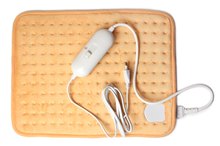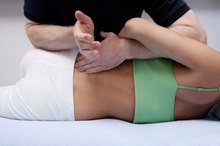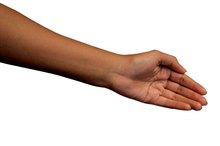Pinched Femoral Nerve Treatments
The femoral nerve is one of the largest nerves in the leg 2. The nerve and its branches supply sensation to the upper thigh and control the quadriceps muscle, which is responsible for straightening the knee. Femoral nerve pinching, or impingement, can cause various symptoms. Numbness or tingling down the thigh or leg may be present. Shooting pain into the leg may also occur, particularly into the groin area. Thigh muscle weakness can occur and may cause knee buckling. Symptoms typically result from direct trauma or prolonged pressure on the femoral nerve. Several treatments can alleviate femoral nerve impingment symptoms.
If you are experiencing serious medical symptoms, seek emergency treatment immediately.
Rest and Medication
Rest can be used initially to diminish symptoms. Avoiding activities such as running, jumping or squatting during this time prevents further irritation of the compressed femoral nerve. If knee buckling occurs, a knee brace may be recommended to prevent falls. Your doctor may recommend antiinflammatory medication, such as ibuprofen (Advil, Motrin), naproxen (Aleve) or aspirin, for pain control. Neurogenic pain medications, such as gabapentin (Lyrica), are sometime prescribed to help relieve shooting pain, numbness or tingling. In some cases, cortisone injections or nerve blocks can also be helpful in alleviating femoral nerve pain.
- Rest can be used initially to diminish symptoms.
- In some cases, cortisone injections or nerve blocks can also be helpful in alleviating femoral nerve pain.
Alleviating Compression
Ulnar Nerve Damage From Cycling
Learn More
One common cause of a pinched femoral nerve is wearing tight pants or belts. Tightness in the waist or groin area can compress the femoral nerve and cause symptoms in the leg. Wearing less restrictive clothing can eliminate the impingement and reduce symptoms. Excessive weight, particularly in the stomach and waist, can also contribute to compression of the femoral nerve. Weight loss can be helpful at relieving the impingement and diminishing symptoms in overweight individuals.
- One common cause of a pinched femoral nerve is wearing tight pants or belts.
- Excessive weight, particularly in the stomach and waist, can also contribute to compression of the femoral nerve.
Nerve Gliding
Adhesions, which occur when scar tissue builds up and compresses a nerve, may be responsible for femoral nerve impingement. An exercise called nerve gliding can be used to free the nerve from the adhesions by gently pulling the nerve taut and then releasing it. This exercise can be performed by lying on your stomach and gently bending the knee on the affected side with the toes pointed until a stretch is felt. Numbness or tingling may slightly increase. The nerve glide can be held for a few seconds before it is released by straightening the leg. This exercise is commonly performed 3 to 5 minutes at a time, several times per day.
- Adhesions, which occur when scar tissue builds up and compresses a nerve, may be responsible for femoral nerve impingement.
- The nerve glide can be held for a few seconds before it is released by straightening the leg.
Stretching and Exercise
How to Treat a Sciatic Nerve After Back Surgery
Learn More
The femoral nerve passes through the groin before making its way down the leg. Tightness in the hip flexor muscles near the groin can contribute to compression of the nerve. These muscles can be stretched by kneeling on the affected leg and placing the other foot in front of you with the knee bent at a 90 degree angle. Slowly leaning forward while allowing the front knee to bend until a stretch is felt in the groin of the affected leg helps reduce tightness. This stretch is typically for 30 seconds and performed 3 to 5 times, several times daily. Strengthening exercises may also be recommended by a physical therapist to ensure this tightness does not recur.
- The femoral nerve passes through the groin before making its way down the leg.
- Slowly leaning forward while allowing the front knee to bend until a stretch is felt in the groin of the affected leg helps reduce tightness.
Warnings and Precautions
Make sure to inform your doctor if symptoms persist or worsen, as this could be a sign of something more serious. Ultimately, surgery may be necessary to relieve symptoms in cases where conservative treatment fails to improve the pain, numbness, tingling or weakness.
Related Articles
References
- Journal of Neurosurgery: Management of Meralgia Paresthetica
- European Journal of Neurosurgery: Decision Making in the Surgical Treatment of Meralgia Paresthetica: Neurolysis vs Neurectomy
- MedlinePlus. Coronary angiogram. February 22, 2018.
- MedlinePlus. Blood gases. Updated July 20, 2018.
- Jindeel A. Claudication: a teachable moment or missed opportunity! Clin Med Rev Case Rep. 2017;4:186. doi:10.23937/2378-3656/1410186
- Niino T, Unosawa S, Kimura H. Ruptured common femoral artery aneurysm or abdominal aortic aneurysm? Case Rep Surg. 2013;2013:306987. doi:10.1155/2013/306987
- Stanford Medical Hospital. Femoral popliteal bypass.
- UCSD’s Practical Guide to Clinical Medicine. University of California San Diego website.
- Femoral Artery. Kenhub GmbH website.
- Femoropopliteal & Femorodistal Bypass. Circulation Foundation website.
- Lew, Valerie. Kang, Michael. Anatomy, Abdomen, and Pelvis, Femoral Sheath. Treasure Island, FL: StatPearls Publishing, LLC.; 2019.
- Menard M, Belkin M. Peripheral aneurysms. Comprehensive Vascular and Endovascular Surgery. 2009;2:579-91. doi:10.1016/B978-0-323-05726-4.00036-6
Writer Bio
Tim Petrie is a Physical Therapist and an Orthopedic Certified Specialist working in Milwaukee, Wisc. When he isn't working, he loves distance running, Packers football, and traveling with his wife and his energetic kids.









